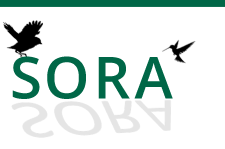Abstract
Los estudios a largo plazo en ornitología constituyen una herramienta fundamental que permite el monitoreo de las poblaciones a lo largo del tiempo. En este sentido, el Censo Neotropical de Aves Acuáticas (CNAA) constituye un estudio a largo plazo de las aves acuáticas a nivel regional. En Venezuela se viene realizando desde el año 2006, llenando un vacío de información en cuanto a censos realizados en el país. El objetivo de este trabajo consiste en presentar los resultados del CNAA en Venezuela (CNAAV) durante el año 2014. Se contabilizaron un total de 1.532.261 avistamientos, 771.082 en febrero y 760.132 en julio, pertenecientes a 82 especies, 67 en febrero y 62 en julio. Se realizaron censos en ocho estados y 22 localidades. A pesar de haberse censado una menor cantidad de localidades con respecto al CNAAV del 2013, se registró una abundancia total mucho mayor. Se reportaron 21 especies migratorias neárticas; 47 especies residentes y 9 especies residentes con poblaciones que migran del neártico. La especie migratoria neártica más abundante, al igual que el año anterior, fue el Barraquete Aliazul Anas discors, seguidas del Tigüi-Tigüe Chico Tringa flavipes y el Playerito Menudo Calidris minutilla. En cuanto a las especies residentes, las más abundantes fueron Cotúa Olivacea Phalacrocorax brasilianus y el Flamenco Phoenicopterus ruber. Se observó una especie amenazada: la Cotarita de Costados Castaños Laterallus levraudi. Se ha registró una disminución en las abundancias de diversas especies de playeros: el Tigüi-Tigüe Chico Tringa flavipes, la Viudita Patilarga Himantopus mexicanus y el Chorlo Real Numenius phaeopus entre otros, lo cual podría estar relacionado con una menor cantidad de localidades censadas.
The long-term studies in ornithology are an essential tool for monitoring populations over time. In this sense, the Neotropical Waterbird Census (CNAA) is a long-term study of waterfowl at regional level. In Venezuela it has been running since 2006, filling an information gap regarding surveys conducted in the country. The aim of this paper is to present the results of CNAA in Venezuela (CNAAV) during 2014. A total of 1.532.261 sightings, 771.082 in February and 760.132 were counted in July, belonging to 82 species, 67 in February and 62 in July. Censuses in eight states and 22 localities were performed. Despite fewer locations have regarding CNAAV census of 2013, total recorded much greater abundance. Twenty one Nearctic migratory species were reported; 47 resident species and 9 species resident populations migrating shorebirds.The most abundant nearctic migratory species, like the previous year, was the Blue-winged Teal Anas discors. Regarding the resident species, the most abundant were the Neotropic Cormorant Phalacrocorax brasilianus and Flamingo Phoenicopterus ruber. One endangered species was observed, the Rusty-flanked Crake Laterallus levraudi. There has been a decrease in the abundance of several species of shorebirds: the Lesser Yellowlegs Tringa flavipes, the Black-necked Stilt Himantopus mexicanus and Whimbrel Numenius phaeopus among others, which may be related to fewer surveyed locations.
Creative Commons License
Recommended Citation
Sainz-Borgo, Cristina; Giner, Sandra; Espinoza, Frank; Fernández-Ordoñez, Juan Carlos; García, Daniel; López, Eduardo; Martínez, Margarita; Porta, Alberto; Sanz, Virginia; and Torres, Lermith
(2015)
"Censo Neotropical de Aves Acuáticas en Venezuela 2014 / Neotropical Waterbird Census in Venezuela 2014,"
Revista Venezolana de Ornitología: Vol. 5
:
Iss.
1
, Article 3.
Available at:
https://digitalcommons.usf.edu/rvo/vol5/iss1/3

